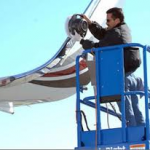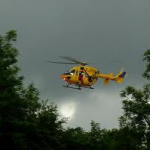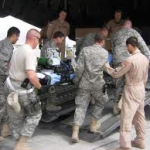Air ambulances were useful in remote areas, but their usefulness in the developed world was still uncertain. Following the end of the World War II, the first civilian air ambulance in North America was established by the Saskatchewan government in Regina, Saskatchewan, Canada, which had both remote communities and great distances to consider in the provision of health care to its citizens. The Saskatchewan Air Ambulance service continues to be active as of 2011.
In the USA, the country’s first air ambulance service, the Schaefer Air Service, was founded by J. Walter Schaefer in 1947 in Los Angeles, California, and operated by Schaefer Ambulance Service. Schaefer Air Service was also the first FAA-certified air ambulance service in the United States. At the time of the creation of the Schaefer and Saskatchewan services, paramedicine was still decades away, and unless the patient was accompanied by a physician or nurse, they operated primarily as medical transportation services. A great deal of the early use of aircraft as ambulances in civilian life, particularly helicopters, involved the improvised use of aircraft belonging to branches of the military. Eventually this would become more organized. This mode of usage occurred not only in the United States, but also in other countries, and persists to this day. Today, there are approximately a half million rotor-wing (helicopter) and fixed-wing (airplane) transports each year in the U.S.
Two programs were implemented in the U.S. to assess the impact of medical helicopters on mortality and morbidity in the civilian arena. Project CARESOM was established in Mississippi in 1969. Three helicopters were purchased through a federal grant and located strategically in the north, central, and southern areas of the state. Upon termination of the grant, the program was considered a success and each of the three communities was given the opportunity to continue the helicopter operation. Only the one located in Hattiesburg, Mississippi did so, and it was therefore established as the first civilian air medical program in the United States. The second program, the Military Assistance to Safety and Traffic (MAST) system, was established in Fort Sam Houston in San Antonio in 1969. This was an experiment by the Department of Transportation to study the feasibility of using military helicopters to augment existing civilian emergency medical services. These programs were highly successful at establishing the need for such services. The remaining challenge was in how such services could be operated most cost-effectively. In many cases, as agencies, branches, and departments of the civilian governments began to operate aircraft for other purposes, these aircraft were frequently pressed into service to provide cost-effective air support to the evolving Emergency Medical Services.
As the concept was proven, dedicated civilian air ambulances began to appear. On November 1, 1970, the first permanent civil air ambulance helicopter, Christoph 1, entered service at the Hospital of Harlaching, Munich, Germany. The apparent success of Christoph 1 led to a quick expansion of the concept across Germany, with Christoph 10 entering service in 1975, Christoph 20 in 1981, and Christoph 51 in 1989. As of 2007, there are about 80 helicopters named after Saint Christopher, like Christoph Europa 5 (also serving Denmark), Christoph Brandenburg or Christoph Murnau am Staffelsee. Austria adopted the German system in 1983 when Christophorus 1 entered service at Innsbruck.
The first civilian, hospital-based medical helicopter program in the United States began operation in 1972. Flight For Life Colorado began with a single Alouette III helicopter, based at St. Anthony Central Hospital in Denver, Colorado. In Ontario, Canada, the air ambulance program began in 1977, and featured a paramedic-based system of care, with the presence of physicians or nurses being relatively unusual. The system, operated by the Ontario Ministry of Health, began with a single rotor-wing aircraft based in Toronto. An important difference in the Ontario program involved the emphasis of service. “On scene” calls were taken, although less commonly, and a great deal of the initial emphasis of the program was on the interfacility transfer of critical care patients. Operating today through a private contractor (ORNGE), the system operates 33 aircraft stationed at 26 bases across the province, performing both interfacility transfers and on-scene responses in support of ground-based EMS. Ornge operates the largest and most sophisticated program of aeromedical transport in North America. Over 17,000 admissions are dispatched annually, making Ornge North America’s largest operator in the field of transport medicine. Today, across the world, the presence of civilian air ambulances has become commonplace, and is seen as a much-needed support for ground-based EMS systems.
Organization
Air ambulance service, sometimes called Aeromedical Evacuation or simply Medevac, is provided by a variety of different sources in different places in the world. There are a number of reasonable methods of differentiating types of air ambulance services. These include military/civilian models and services that are government-funded, fee-for-service, donated by a business enterprise, or funded by public donations. It may also be reasonable to differentiate between dedicated aircraft and those with multiple purposes and roles. Finally, it is reasonable to differentiate by the type of aircraft used, including rotary-wing, fixed-wing, or very large aircraft. The military role in civilian air ambulance operations is described in the History section. Each of the remaining models will be explored separately. It should also be noted that this information applies to air ambulance systems performing emergency service. In almost all jurisdictions, private aircraft charter companies provide non-emergency air ambulance service on a fee-for-service basis.



